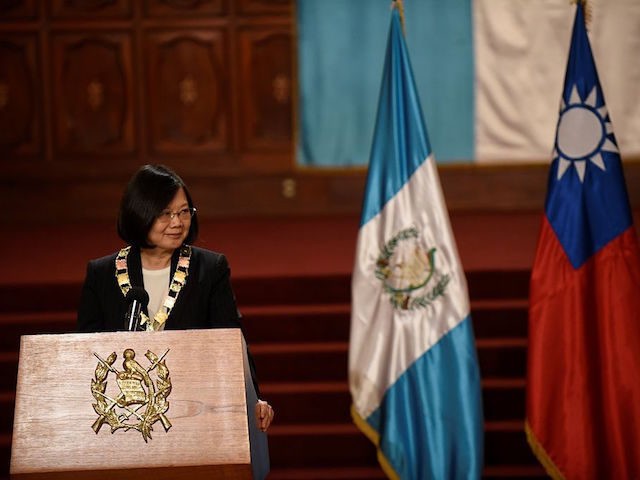Deadly leftist riots throughout Latin America and the leftist regimes in Venezuela, Cuba, and Nicaragua enabling them are unequivocal signs of how fragile Latin American democracies still are.
Sadly, Latin America has many examples of what it takes to be tyranny. It needs a model for how to be free, and across the globe in Taiwan, it may very well find one.
Mass protests in Bolivia in defense of socialist former President Evo Morales, who tried to commit election fraud to stay in power, pose a real danger in the region of the loss of democratic governance and the rule of law. Chile, Ecuador, and Colombia have also experienced destabilizing leftist violence in the last year.
If we add to these realities that Cuba and Venezuela, as well as other sister countries, are under totalitarian tyrannies plagued with corruption and with their people subject to political oppression and material poverty, there is no doubt that serious efforts are needed to support and encourage the democracies that remain in the region. The most symbolic is perhaps Costa Rica.
With an overview and recognition of the differences between Latin American countries, a common factor can be identified in many of them: the absence of a comprehensive, affordable, and successful development model that serves as a reference.
Taiwan has a model that turned an island, sparsely populated and underdeveloped, into a successful nation with an enviable economic model, a democratic system, and an open, diverse, and integrated society where the fundamental rights of the human being are respected and protected.
In honor of its high and growing social development, Taiwan’s government projects and programs are today comparable to those of the most developed and prosperous nations in the world. The Republic of China in Taiwan has left an exemplary stele of progress and abundance in those countries that have opened the doors, without requiring subordination or loss of sovereignty.
In recent years, Latin America has unfortunately and paradoxically moved away from Taiwan’s democratic model of sustainable development, and has grown closer to one that represents the People’s Republic of China’s model. The People’s Republic of China constitutes the most powerful totalitarian government on the face of the earth, adverse to the freedoms and democracy essential for Latin America.
During its growth as a nation, Taiwan incorporated various elements of other countries’ civilizations. For that reason, it is today an open and forward-looking society, as the nations of Latin America should be. Taiwan wishes to thank and reward the international community for the encouragement and support it has received. They would like to make an important contribution to the advancement of the international democratic system because it is convinced that this system generates not only national stability but also international peace, an essential element for all humanity.
Taiwan began showing its willingness to collaborate with other countries in its own region, most notably in Southeast Asia, with the “New Policy towards the South.” The President, Tsai Ing-wen, initiated this policy three years ago to establish a future of common prosperity by substituting competition for collaboration. In addition, Taiwan shares with other countries in South Asia the medical and technological advances of its excellent health care system. For example, Vietnamese surgeons successfully performed their first lung transplant last year after receiving training in Taiwan.
Another example of goodwill is Taiwan’s willingness to accept foreign students. In 2019, more than 51,000 students traveled to Taiwan from South Asia to attend the high-level Taiwanese universities. The “New Policy towards the South” includes programs in various branches such as agriculture, prevention of infectious diseases, academic exchange, and tourism, among others.
Latin America can benefit greatly from this program.
A summary of the statistical figures and the successes achieved by Taiwan in numerous economic, social, political, and cultural lines leaves no room for doubt about the value of the Taiwanese Model:
- Taiwan is the 6th largest world exporter. It manufactures 75 percent of the Integrated Circuits that are produced in the world (Integrated Circuits constitute the heart of all electronic equipment). Its Gross Domestic Product is over $573 billion. It exports a value of $317 billion (2017) and imports $259 billion (2017), which grants it an annual trade surplus of $57 billion. Taiwan accumulates foreign currency reserves worth more than $451 billion. Its annual per capita income is $54,000.
- Taiwan’s education system is excellent. Education is compulsory up to 12th grade. With only 36,000 square kilometers and with a population of 23 million and a half, Taiwan has 144 universities. Moreover, 45 percent of the Taiwanese population over 15 years of age have a degree of higher education. The talent and work ethic of the Taiwanese workforce is the basis of its economic prosperity.
- Culture and the media are in abundance as well. In Taiwan, there are 65 cable television companies, 171 radio stations, 247 newspaper-publishing companies, 1,239 magazine publishing companies, 115 satellite transmission companies, and 32 news agencies.
- Roughly, 98 percent of Taiwanese youth have smartphones.
The union of Taiwan and our region, without a doubt, can be a new beginning for Latin America, a land that frequently oscillates between hope and frustration.
Dr. Orlando Gutierrez-Boronat is a writer, educator, and co-founder and spokesman for the Cuban Democratic Directorate (Directorio).

COMMENTS
Please let us know if you're having issues with commenting.